
Guests
- Greg Mitchelleditor of Nuclear Times magazine from 1982 to 1986. He has written widely about the Hiroshima and Nagasaki atomic bombings, including Hiroshima in America: A Half Century of Denial, with Robert Jay Lifton. His latest is Atomic Cover-Up: Two U.S. Soldiers, Hiroshima & Nagasaki and The Greatest Movie Never Made. Mitchell is a daily contribute to TheNation.com and has been chronicling the lead-up to the bombing in a series of blog coasts called “Countdown to Hiroshima 1945.”
As radiation readings in Japan reach their highest levels since the Fukushima Daiichi nuclear power plant meltdowns, we look at the beginning of the atomic age. Today is the 66th anniversary of the U.S. atomic bombing of Nagasaki, which killed some 75,000 people and left another 75,000 seriously wounded. It came just three days after the United States dropped an atomic bomb on Hiroshima, killing around 80,000 people and injuring some 70,000. By official Japanese estimates, nearly 300,000 people died from the bombings, including those who lost their lives in the ensuing months and years from related injuries and illnesses. Other researchers estimate a much higher death toll. We play an account of the 1945 atomic bombing of Nagasaki by the pilots who flew the B-29 bomber that dropped that bomb, and feature an interview with the son of Pulitzer Prize-winning journalist George Weller, who was the first reporter to enter Nagasaki. He later summarized his experience with military censors who ordered his story killed, saying, “They won.” Our guest is Greg Mitchell, co-author of “Hiroshima in America: A Half Century of Denial,” with Robert Jay Lifton. His latest book is “Atomic Cover-Up: Two U.S. Soldiers, Hiroshima & Nagasaki and The Greatest Movie Never Made.” [includes rush transcript]
Transcript
AMY GOODMAN: “The worst nuclear disaster to strike Japan since a single bomb fell over Nagasaki in 1945 occurred in the spring of 2011 at the Fukushima nuclear power plant following the epic tsunami. Just last week, it was reported that radiation readings at the site had reached their highest points to date. The wide release of radiation, and fear of same, has forced the Japanese and others all over the world to reflect on what happened to the country in 1945, and the continuing (but usually submerged) threat of nuclear weapons and energy today.”
Those are the words of Greg Mitchell, co-author of the book Hiroshima in America: A Half Century of Denial. Mitchell is our guest today. He has also written Atomic Cover-Up: Two U.S. Soldiers, Hiroshima & Nagasaki, and The Greatest Movie Never Made.
Yes, today is the 66th anniversary of the U.S. atomic bombing of Nagasaki, which killed some 75,000 people and left another 75,000 seriously wounded. It came just three days after the U.S. dropped an atomic bomb on Hiroshima, killing around 80,000 people, injuring some 70,000. By official Japanese estimates, nearly 300,000 people died from the bombings, including those who lost their lives in the ensuing months and years from related injuries and illnesses. Other researchers estimate a much higher death toll. The atomic bombings of Japan remain the only time nuclear weapons have been used in war to date.
At a ceremony over the weekend, the Japanese prime minister, Naoto Kan, honored the dead from the World War II bombing, adding he deeply regrets having believed the so-called “security myth,” which suggested Japan could be safely powered by the same atomic forces that instantly killed so many Japanese people over six decades ago.
Well, today, we’ll look at the Hiroshima and Nagasaki bombings and their legacy amidst Japan’s ongoing nuclear crisis. We turn first to Nagasaki through the story of the Pulitzer Prize-winning journalist George Weller. Weller was the first reporter to enter Nagasaki, defying a U.S. media ban in southern Japan. He worked for the Chicago Daily News, hired a rowboat to get himself to Nagasaki. He wrote a 25,000-word report on the horrors he encountered. When he submitted his story to the military censors, General Douglas MacArthur personally ordered the story killed, and the manuscript was never returned. George Weller later summarized his experience with the government censors, saying, “They won.”
Well, six years ago, George Weller’s son Anthony discovered a copy of the suppressed dispatches among his late father’s papers. George Weller died in 2002. They’re now published as a book called First into Nagasaki: The Censored Eyewitness Dispatches on Post-Atomic Japan and Its Prisoners of War. This is an excerpt of an interview that Juan Gonzalez and I did with Anthony Weller, George Weller’s son, shortly after he first discovered his late father’s papers.
ANTHONY WELLER: Well, I think the thing that astonished him the most—I mean, there were many things that he found astonishing. Remember, he went in there four weeks, almost to the minute, after the bomb was dropped, which was on the 6th of September in mid-morning, is when he arrived. And he was struck, obviously, by several things—by the physical appearance of the city, which was still smoldering here and there, by the surgical precision of the bomb itself. Later, he was to learn that, in fact, a great deal of damage had been done not just by the bomb, but by the fires that erupted, because people were cooking their midday meal when the bomb hit, and a number of wooden residences just caught fire, and the fire spread. So, in a way, it was kind of like a Dresden.
And as he went around the ruins of the city and rapidly began visiting all the hospital facilities that still existed, I know he was struck immediately, first by the absence of any American medical personnel there—four weeks later, there were still no doctors or nurses—and then, by the great precision and care with which the Japanese doctors had already catalogued the effects of the bomb on individual organs of the body.
And over the next few days, he was as astonished as the Japanese doctors were, of course, by what he referred to in his reports as “Disease X.” It was perhaps not so astonishing to see some of the scorches and burns that people had suffered, but to see people apparently unblemished at all by the bomb, who had seemingly survived intact, suddenly finding themselves feeling unwell and going to hospital, sitting there on their cots surrounded by doctors and relatives who could do nothing, and finding when he would go back the next day that they had just died, or that, let’s say, a woman who had come through unscathed making dinner for her husband and having the misfortune to make a very small cut in her finger while peeling a lemon, would just keep bleeding, and bleed to death, because the platelets in her bloodstream had been so reduced that the blood couldn’t clot anymore.
So there were case after case like this, and, in a way, I think my father found them more poignant than the obvious destruction or the obvious burn victims, because here was a whole team of Japanese doctors, very able, very aware from long before the war had started about the potentials of radiation, absolutely baffled. And he had a wonderful phrase he used. He said the effects of the bomb uncured because—excuse me, the effects of “Disease X,” which is what they were calling it, uncured because it is untreated, and untreated because it is undiagnosed.
AMY GOODMAN: Anthony Weller, the son of George Weller, whose story on the Nagasaki bombings was blocked by military censors. As we turn now to an account of the 1945 atomic bombing of Nagasaki by the pilots who flew the B-29 bomber that dropped that bomb. This is an excerpt of the documentary Hiroshima Countdown, produced by Andrew Phillips.
REPORTER: This is one of a series of interviews conducted by the Air Force historical division. Today, we are interviewing Brigadier General Paul W. Tibbets, Jr.
PAUL TIBBETS, JR.: They were definitely military targets. There was no question about that. And they offered such a—well, you could almost say a classroom experiment, as far as being able to determine later the bomb damage. These were good virgin targets, and they were ideal for the purpose that we wanted to use them for.
The consideration of targets would be Hiroshima, Nagasaki, Niigata, Kokura, and there’s one more that I don’t remember. The 20th Air Force had been told they would not attack those targets under any circumstances. In other words, the ground was laid.
NARRATOR: As well as these targets, Kyoto, Japan’s ancient capital, was strongly recommended by the man with overall control of the bomb project, General Leslie Groves. But Secretary of War Henry Stimson, approaching 80 years of age, would not have it. He had visited Kyoto with his wife in the '20s and had enjoyed the city's cultural riches. It was a city of great religious significance to the Japanese, and Stimson felt Kyoto’s destruction would damage America’s post-war stature.
UNIDENTIFIED: The selection of the targets in the month of May 1945 was actually done by the intelligence community in headquarters, U.S. Air Force. The requirements given to them was: You will select cities that have military targets in them. And they also selected the type of terrain that they wanted. They also were interested in the type of construction that they could expect to run into, because in reality not only was this a military mission, but it was also of extreme scientific importance, because they wanted to know what a weapon of this type could do against reinforced concrete, what it could do against steel, what it would do against anything that was in the building materials line. It had to be something that had not been attacked by the 20th Air Force up to that time, call it virgin targets, undamaged, unhurt by any other type of an explosive or munition.
CHARLES SWEENEY: I know the type of bomb we were working on…
NARRATOR: Charles Sweeney flew with Tibbets in an observer aircraft to witness the bombing of Hiroshima. Three days later he lead his crew first to Kokura, the primary target for the second bomb, and then to Nagasaki. Kokura was clouded in that day.
CHARLES SWEENEY: As he was talking, he picked up a handful of earth. He said, “Basically what we’re working on is a single bomb that will turn a whole city into this.” And he just tossed a handful of sand into air.
AMY GOODMAN: The voices of the men who loaded and flew the B-29 bomber that dropped the atomic bomb on Nagasaki, August 9, 1945, from the documentary Hiroshima Countdown, produced by Andrew Phillips. We’ll link to the whole documentary at democracynow.org. When we come back from break, we’ll speak with a man who has followed this story for decades, the author of Atomic Cover-Up, Greg Mitchell. Stay with us.
[break]
AMY GOODMAN: Our guest is Greg Mitchell. He writes the “Media Fix” blog for TheNation.com. He is the author of numerous books. His latest is Atomic Cover-Up: Two U.S. Soldiers, Hiroshima & Nagasaki, and The Greatest Movie Never Made.
Welcome. You have been covering this for decades. The significance, Greg, of this day, August 9th, 66 years ago, and what it means today in a nuclear-ravaged Japan.
GREG MITCHELL: Right. Well, of course, it’s particularly poignant, given the Fukushima nuclear disaster and the—similarly to after Hiroshima-Nagasaki, the fears of so many people that they’ve been tainted by released radiation. And so, the psychological effects of the nuclear disaster are severe. And the other—in fact, survivors of the atomic bomb in Hiroshima and Nagasaki have been campaigning this year against nuclear power, which is something they haven’t particularly done in the past, linking nuclear weapons and nuclear power, the fear of radiation, the chance of catastrophe, the chance of disaster. So it’s a special day for that.
And, of course, the other reason is because, as I’ve pointed out for many years, the U.S. is the only country that has used the bomb twice in war, as you mentioned. And, you know, it may surprise many people to know we still have a first-use policy in the United States. And the lesson that has been handed down to us for decades now is that, yes, never again, we should never use nuclear weapons again; however, we continue—most Americans, certainly American leaders, American policymakers, American media—all defend the use of the bomb, or the double use of the bomb, back in 1945. So the message is, these weapons are too dangerous to use, but we used them before, we continue to defend it, we continue to have a first-strike policy. So, to me, that’s a very dangerous lesson of Hiroshima and Nagasaki.
AMY GOODMAN: Talk about the color videotape of the atomic bombing that has rarely been shown.
GREG MITCHELL: Right.
AMY GOODMAN: And yet, it’s been around, well, since after, right after, the bombing.
GREG MITCHELL: Right. Well, that’s basically what my new book is about. It’s about the suppression of this footage, both the American footage, which is in color and was shot by the U.S. military, and the Japanese footage, which was shot by the Japanese newsreel team and is in black and white. In fact, in your first part of this program, almost all the images that people saw on the screen was black-and-white footage. Even to this day, not many people have seen much of the color footage, and that’s because the U.S. suppressed that color footage, shot by our own military, for decades. And it really wasn’t until the 1980s that any of it came out. Snippets have been used in film, you know, so we see a little bit more of it now. But in this key moment in our nuclear history, as nuclear power was becoming entrenched, as a nuclear arms race continued for decades, Americans were not exposed to the full truth of the bomb.
AMY GOODMAN: Interestingly, the scientists at Los Alamos who made the bomb, most of them thinking that it would be used, if need be, on Germany—
GREG MITCHELL: Right.
AMY GOODMAN: —actually were privately shown this video, weren’t they?
GREG MITCHELL: Yeah. And so, the video was taken by the Pentagon, and parts of it were made into training films to show—you know, show our policymakers and our military what the bomb could do. What my book focuses on is two U.S. military officers who shot the footage, and then, for decades after, tried to get it released, tried to get it shown on TV, tried to get it made into a movie—
AMY GOODMAN: Tell us their names.
GREG MITCHELL: —to be shown in theaters. Daniel McGovern and Herbert Sussan. And they tried for decades to get it released and shown to a wider public, and it really didn’t happen until, you know, just a few years ago.
AMY GOODMAN: Talk about the YouTube video that you just didn’t think was particularly controversial. It was a kind of promo for your book—
GREG MITCHELL: Right.
AMY GOODMAN: —illustrating your point.
GREG MITCHELL: Yeah. Well, it’s—if people search for it on YouTube under “Atomic Cover-Up,” they’ll find it. It’s just a two-minute video. And it includes some of the suppressed footage. And I think that’s why, after I loaded it on YouTube, I got a notice from Google that they were not going to allow any ads for it, because it showed—because of the “promoted violence,” as they said, which was of course 180 degrees from what it really did. It’s sort of against violence and against war. And, of course, the real irony was that it was an act of suppression about a book and a video that is about suppression. So, there were—a lot of people protested, and that sort of ended it after a few days.
AMY GOODMAN: Well, speaking of the stories that were told about what happened in Hiroshima and Nagasaki, I wanted to go to Wilfred Burchett, the first journalist to make it into Hiroshima—
GREG MITCHELL: Right.
AMY GOODMAN: —which was bombed three days before Nagasaki—it was bombed August 6, 1945—an Australian reporter who defied the U.S. military ban, who took a train for 30 hours. The whole area of southern Japan was off-limits. He took this train to Hiroshima. In this recording, an excerpt from the documentary of Andrew Phillips called Hiroshima Countdown, Burchett describes what he saw.
WILFRED BURCHETT: I went to a hospital, which had survived in the outskirts of the city. These people were all in various states of physical disintegration. They would all die, but they were giving them whatever comfort could be given until they died. And the doctor explained that he didn’t know why they were dying. The only symptoms they could isolate from a medical point of view was that of acute vitamin deficiency. So they started giving vitamin injections. Then he explains where they put the needle in, then the flesh started to rot. And then, gradually, the thing would develop this bleeding which they couldn’t stop, and then the hair falling out. And the hair falling out was more or less the last stage. And the number of the women who were lying there with sort of halos of their black hair which had already fallen out. I felt staggered, really staggered by what I’d seen. And just where I sat down, I found some lump of concrete, I remember, that had not been pulverized. I sat on that with my little Hermes typewriter, and my first words, I remember now, were, “I write this as a warning to the world.”
AMY GOODMAN: “I write this as a warning to the world,” Wilfred Burchett wrote, his reporting exposing the horrors of the bombings and particularly talking about—well, he didn’t have the words for radiation. He talked about an “atomic plague.”
The New York Times correspondent told a very different story. The reporter, William Laurence, was not just working for the Times, though. He was also on the payroll of the U.S. War Department. That’s what the Pentagon was called at the time. Laurence wrote military press releases and statements for President Harry Truman and Secretary of War Stimson, all the while faithfully parroting the line of the U.S. government in the pages of the New York Times. He was awarded the 1946 Pulitzer Prize for his reporting on Nagasaki, as well as on the U.S. government’s development of the atomic bomb. His work was crucial in launching a half-century of silence about the deadly lingering effects of the bomb.
In 2005, I joined my brother, the journalist David Goodman, to call on the Pulitzer board to strip Laurence and the New York Times of the Pulitzer for their atomic bomb reporting. Juan Gonzalez and I talked to David on Democracy Now! about the William Laurence’s deception.
DAVID GOODMAN: William Laurence was—had immigrated to the United States from Lithuania in the 1930s, at a time when actually the New York Times was laying off reporters, due to the Great Depression. They asked Laurence to become both the newspaper’s and the nation’s first dedicated science reporter. Laurence was—became fascinated with atomic power and atomic weapons and was an ardent supporter of atomic power in the articles that he wrote throughout the 1930s and into the early 1940s. This is probably what caught the attention of the War Department.
In the spring of 1945, a remarkable meeting took place, secretly, at the headquarters of the New York Times in Times Square in New York City. General Leslie Groves, the director of the Manhattan Project, which was the name of the program that was developing atomic bombs for the U.S. military, came to Times Square to the New York Times and met secretly with Arthur Sulzberger, the publisher of the New York Times, the editor-in-chief of the New York Times, and William Laurence. At that meeting, he asked Laurence if he would become a paid publicist, essentially, for the Manhattan Project. So, while simultaneously working as a newspaper reporter for the New York Times, he would also be writing essentially propaganda for the War Department. Officially he was asked to put in layman’s terms the benefits of atomic weapons and the development of atomic power. Other New York Times reporters were unaware of this arrangement, this dual arrangement where he was being paid by both the government and the newspaper, and in fact were somewhat mystified when Laurence began taking long leaves of absence.
Well, the government’s investment in Laurence paid off in spades, because he was rewarded for his loyalty. He was also writing—ended up writing statements for Secretary of War Stimson and for President Truman himself. He was rewarded by being given a seat in the squadron of planes that dropped the atomic bomb on Nagasaki. I’ll read to you a little excerpt of Laurence’s dispatch. In general, his writing—well, these days journalists would call it “purple prose,” but it was often imbued with these messianic themes about the potential and power of atomic weapons.
Here’s what he had to say in describing the bombing of Nagasaki. This bombing is thought to have taken about 70,000 to 100,000 lives. Laurence recounted, quote, “Being close to it and watching it as it was being fashioned” —he’s speaking here of the atomic bomb— “into a living thing so exquisitely shaped that any sculptor would be proud to have created it, one felt oneself in the presence of the supernatural.”
Now, Laurence went on to write a series of 10 articles about the development of the atomic bomb. This is—this and his reporting about the Nagasaki bombing won him the 1946 Pulitzer Prize in reporting. He seems to have been completely unashamed and unrepentant of what was clearly an egregious conflict of interest by any of the most basic canons of journalism ethics. Laurence later wrote in his memoirs about his experience as a paid publicist for the War Department. He wrote, quote, “Mine has been the honor, unique in the history of journalism, of preparing the War Department’s official press release for worldwide distribution. No greater honor could have come to any newspaperman, or anyone else for that matter.”
AMY GOODMAN: David, I think it’s instructive, the effects of this reporting. I mean, on the one hand, you had someone like Wilfred Burchett on the ground, talking about—he didn’t even have the words to describe. He talked about “bomb sickness.” He talked about “atomic plague.” And then you have Laurence’s front-page story, September 12th, 1945, “U.S. Atom Bomb Site Belies Tokyo Tales: Tests on New Mexico Range Confirm that Blast and Not Radiation Took Toll.” This, after William Laurence, while he didn’t go to Hiroshima, was taken by Leslie Groves, the general in charge of the Manhattan Project, that was responsible for the bomb, took Laurence and other reporters to New Mexico to counter what the War Department, what Groves was calling Japanese propaganda of the effects, the deadly effects of radiation.
DAVID GOODMAN: And, in fact, Laurence knew better, because having observed the Trinity test, the first explosion of the atomic bomb in the deserts of New Mexico, he knew that Geiger counters had spiked around the area of the bombing long after the actual bomb itself. In fact, an interesting footnote to this whole encounter is that when Laurence was brought by Groves in this effort, as Amy describes…
AMY GOODMAN: We’re going to pull out of that clip of David Goodman describing William Laurence. William Laurence, Greg Mitchell, the original embedded reporter, won a Pulitzer Prize for his reports, was also on the payroll of the War Department, writing the Stimson press releases and statements.
GREG MITCHELL: Right, right. Well, it was—I mean, he’s a symbol, I guess, but really it was—we’ve had decades of the suppression. You know, my book talks about the film footage, which was extremely significant, but, of course, in the media and in the official statements by the government, there was basically a Hiroshima narrative. And it was important that it get established early, and then it be maintained, because of the arms race. We wanted to build the hydrogen bomb, which we did a few years later. And so, it’s been important to the development both of nuclear weapons and nuclear energy in the U.S. that this Hiroshima narrative be disseminated. And, you know, really, from the first words of the nuclear age, it was lie when Truman said that they bombed Hiroshima, which was merely a military base. And so, it’s been 66 years of that kind of misstatements and misleading arguments.
AMY GOODMAN: The words “nuclear power,” “nuclear weapons” and “suppression of information” follow through right to today.
GREG MITCHELL: Right.
AMY GOODMAN: And this is where we’re going to end, as the Japanese people deal with their government in the last few days, hearing that the radiation levels are highest than they’ve ever been since the nuclear meltdowns.
GREG MITCHELL: Right, right, yeah, that’s—it’s continuing today, certainly, in Japan. And one fears it would happen in the U.S., as well, if we had a nuclear crisis here. So, it seems like anything that nuclear weapons or the nuclear energy touches leads to suppression and leads to danger for the public.
AMY GOODMAN: Greg Mitchell, his latest book is Atomic Cover-Up: Two U.S. Soldiers, Hiroshima & Nagasaki, and The Greatest Movie Never Made. A contributor at TheNation.com, he was the editor of Nuclear Times in the 1980s, has written widely about Hiroshima and Nagasaki atomic bombings. This is Democracy Now!, democracynow.org, The War and Peace Report. We’ll link to his articles at democracynow.org.

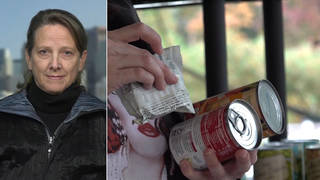
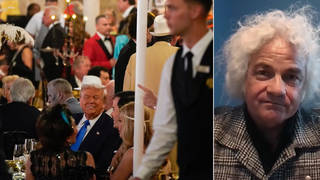
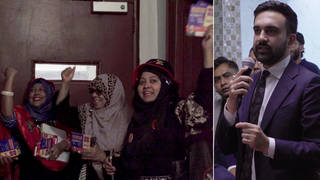
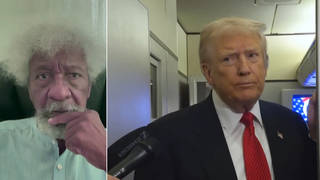






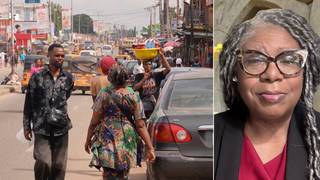
Media Options